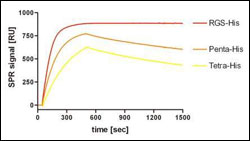Pair-wise Epitope mapping of monoclonal antibodies

The graph shows the binding of an RGS-His fusion protein to immobilised antibodies against a tetra-His, a penta-His and an RGS-His epitope. All antibodies recognize the epitope but only the anti-RGS-His antibody shows no dissociation when bound to the RGS-fusion protein after an association time of 450 seconds.
A complete characterization of monoclonal antibodies also includes the determination of epitope specificity for a given set of monoclonal antibodies. Epitope mapping is a powerful tool in analysing the surface topography of an antigen. The binding of an antibody to the antigen defines a specific binding site or epitope which sterically interferes with the binding of another antibody which has the same or a closely located binding site. The specificity of pairs of antibodies can easily be determined by testing the simultaneous binding to the antigen. Dinstinct binding sites can be identified by binding of both antibodies in parallel whereas an identical or closely located binding site prevents binding of the second antibody. BIA technology (Biomolecular Interaction Analysis) is ideally suited to automatically test panels of monoclonal antibodies and define their epitope specificity pattern.
Our antibody service “eitope mapping” includes the generation of working plans for the experimental setup, the performance of the epitope mapping analysis on a Biacore instrument and the complete evaluation of the results documented in a written report with figures. This report provides you with information about the epitope specificity pattern for your set of monoclonal antibodies i.e. which antibodies bind to the same epitope and which can bind simultaneously because they have different binding sites on the antigen. Please enquire for a detailed quote concerning your specific problem.
Media Contact
More Information:
http://www.biaffin.comAll latest news from the category: Life Sciences and Chemistry
Articles and reports from the Life Sciences and chemistry area deal with applied and basic research into modern biology, chemistry and human medicine.
Valuable information can be found on a range of life sciences fields including bacteriology, biochemistry, bionics, bioinformatics, biophysics, biotechnology, genetics, geobotany, human biology, marine biology, microbiology, molecular biology, cellular biology, zoology, bioinorganic chemistry, microchemistry and environmental chemistry.
Newest articles

Silicon Carbide Innovation Alliance to drive industrial-scale semiconductor work
Known for its ability to withstand extreme environments and high voltages, silicon carbide (SiC) is a semiconducting material made up of silicon and carbon atoms arranged into crystals that is…

New SPECT/CT technique shows impressive biomarker identification
…offers increased access for prostate cancer patients. A novel SPECT/CT acquisition method can accurately detect radiopharmaceutical biodistribution in a convenient manner for prostate cancer patients, opening the door for more…

How 3D printers can give robots a soft touch
Soft skin coverings and touch sensors have emerged as a promising feature for robots that are both safer and more intuitive for human interaction, but they are expensive and difficult…





















